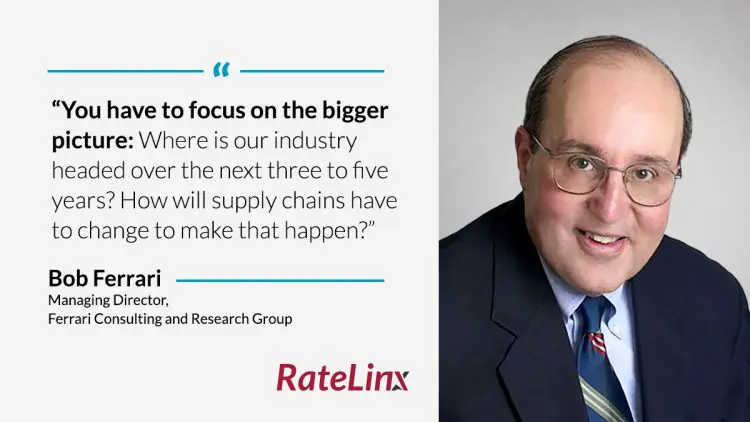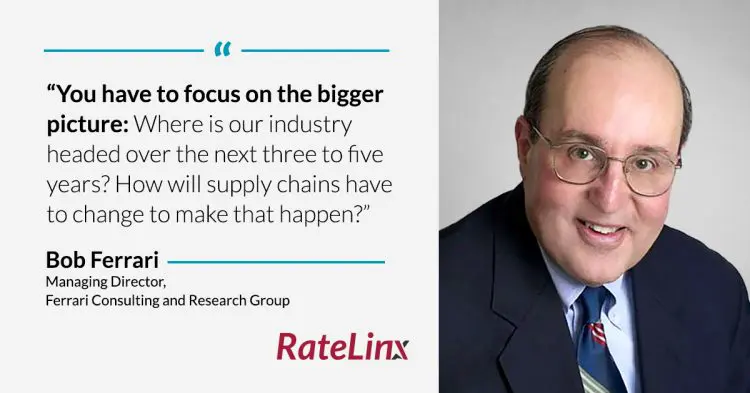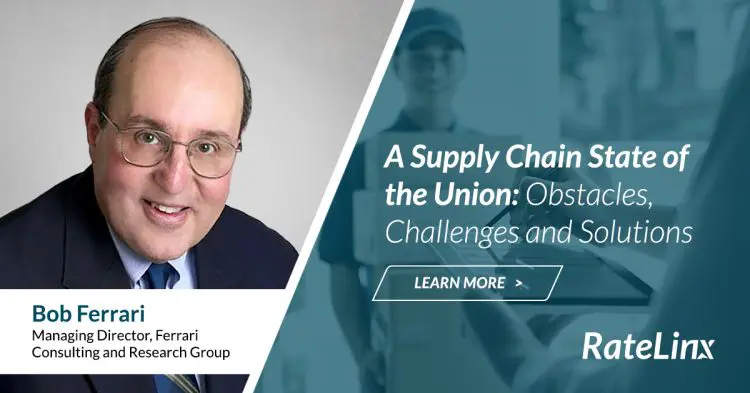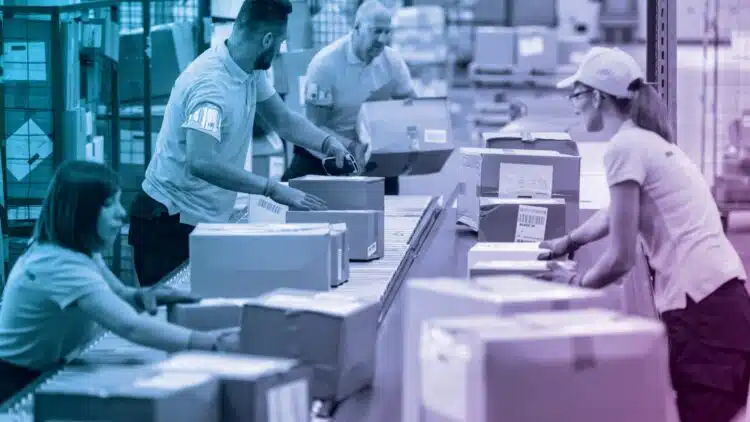It’s easy to make sweeping statements like, “Supply chain strategy is changing, and businesses need to keep up with the changes.” That’s a true statement, of course, but it’s not a particularly informative one. What, specifically is changing? Why is it changing?
Most importantly, what should supply chain leaders do about it?
To drill into the specifics, we asked consultant and supply chain expert Bob Ferrari for his insight. Bob is the Managing Director of the Ferrari Consulting and Research Group. He also maintains the indispensable Supply Chain Matters blog, a go-to resource for supply chain leaders.
Read on for Bob’s thoughts on why the supply chain has to evolve, what issues he’s seeing in the industry, and the best way for supply chain leaders to move forward with their supply chain strategy.
Featured Expert

Bob Ferrari
Bob is an expert in supply chain management, with an emphasis on digital transformation and technology architecture and strategy. In addition to his consulting work, Bob publishes the Supply Chain Matters blog.
Three Forces Making Supply Chain Transformation an Imperative
In our interview, Bob identified three major forces that are necessitating change in supply chain strategy and operations:
1. Online Commerce & Shipping Demands
For Bob, the biggest driver of change in supply chain is due to the disruption from a certain deep-pocketed online retailer: “Everybody talks about the Amazon effect, and I think it’s really being driven home now,” Bob says. “Not every company can afford to spend $9 billion a quarter on transportation and logistics. That level of spend and capability really raises the table stakes. Today, consumers expect same-day or one-day deliveries. That taxes a lot of our existing customer logistics and fulfillment networks.”
2. Tariffs and Trade Wars
While Amazon has certainly changed the game in terms of shipping and fulfillment, there are other forces at play, especially for global organizations. “Trade and tariff tensions are ongoing,” Bob says. “These, in turn, are impacting supply sourcing, as well as adding material costs. So we’ve got lots of industries now trying to deal with all of these cascading impacts.”
Some organizations have taken a “wait-and-see” stance with the US-China tariff war, hoping that the conflict would resolve itself quickly. That’s a mistake, says Bob, and it’s high time to begin strategizing. “What I’ve been telling clients and readers is, even if we get a phase one agreement relative to the current trade tensions, it’s not going away. It’ll be just phase one; there are still going to be some fundamental issues in terms of sourcing and added cost impacts,” Bob says.
3. Climate Change and Sustainability
Tariffs and trade wars are a temporary speed bump compared to Bob’s third driving force: “There are aspects of climate change that could have potential impact on some industries as well,” Bob says. In addition to planning for the effects of climate change, businesses are driven to explore more sustainable solutions for the long term.
But Bob sees sustainability as more than an end unto itself: “The pursuit of sustainable solutions opens up opportunities for cost reduction,” he says. “When you look at areas like housing, materials packaging, product manufacturing, how products move across the supply chain, there are plenty of opportunities available. Logistics and transportation networks are doing their own sustainability, because we all know that that’s one of the target areas for savings.”
As a consultant, Bob and his team have seen sustainability and cost reduction initiatives become more democratized. “At one point, it was consultants using technology for clients, in terms of assessing their supply chain networks, their strategies, and where the opportunities were around sustainability and saving additional costs,” he says. “Now, I think you see more supply chain organizations themselves adopting that technology and doing their own analysis.”
“Even if you think you’ve got your particular data lined up, it may be your provider’s data or your providers’ provider’s data.”
Three Major Challenges to Solve
The forces mentioned above make supply change transformation an imperative, rather than a nice-to-have. As more business supply chain leaders undertake this transformation, however, they’re encountering the same challenges.
1. Misalignment Between Goals and Outcomes
Many organizations supply chain strategy is focused on short-term goals, or goals that focus exclusively on departmental objectives rather than outcomes for the business as a whole. “Alignment with line-of-business objectives and desired business outcomes is crucial,” says Bob.
To properly set goals, Bob suggests coming together to plan for the future: “Where does the business need to be in a within the current year, within the next three years, within the next five years? From that forecast should stem goals that the supply chain can enable, and that supply chain management teams can map to and plan for,” he says.
When the organization is pulling together towards common goals, Bob says, you can “funnel energy into the programs, initiatives, people, process and technology aspects required to achieve your target outcomes.”
Like what you’re reading?
2. A Growing Labor Gap
“Supply chain talent management is a major concern,” Bob says. Granted, there are labor and skill gaps across disciplines and across organizations, but in supply chain the problem is particularly acute. “It’s getting the right people, recruiting them, retaining them, rescaling the existing workforce,” Bob says. “It’s ensuring you have the right set of resources and the right pipeline of skills for the future. The highly skilled folks are in high demand, and they demand big bucks in the market.”
Solving this problem means accepting fundamental changes in the way you recruit talent. “We’re shifting from just putting out a job specification and filling a position, to putting out a skills profile. It’s saying, ‘This is the type of person we need to have. That person is going to fulfill a number of job responsibilities that are going to evolve over months and years,’” Bob says.
It makes sense to hire based on skills rather than job description, Bob argues, because “the people we bring in today are going to have different jobs one year from today, two years from today, three years from today. So you have to pivot to skills-based hiring and recruiting. You’re basically looking to acquire skills in the labor market, and you will have to set compensation levels accordingly.”
3. Difficulty Seeing the Big Picture
The third challenge that Bob sees for supply chain leaders is developing the ability to look beyond their department at the organization as a whole. “You can’t just focus on all things supply chain management — or worse, just your own particular area of supply chain management,” Bob says. “You have to focus on the bigger picture: What’s going on in our industry? Where is our industry headed over the next three to five years? How will supply chains have to change to make that happen?”
Not only do leaders need to look at the bigger picture, Bob says, they also need to use that big picture to inform their own personal development. “Ask yourself: How do I, as an individual, need to change my skills to continue to be in demand during these types of changes?” he says.
Tech-Driven Supply Chain Solutions
The challenges we’ve been discussing here have the same root cause: A lack of shared data across the supply chain and throughout the organization. The solution, Bob says, “is to gain higher levels of supply chain visibility: end-to-end supply chain visibility. It’s about knowing where the materials are at any given point, getting into these dimensions of matching the physical process with the digital process.”
Technology plays a crucial role in developing end-to-end visibility. “The Internet of Things is one particular technology that has a lot of promise in this area, enabling you to know where particular transportation assets are at any given point,” Bob says. “And machine learning can help with verifying data, too. It can say, ‘Hey, this particular facility, their data doesn’t add up.’ And that could be very, very helpful, because sometimes data quality issues permeate multiple tiers of the supply chain. Even if you think you’ve got your particular data lined up, it may be your suppliers data, or your suppliers’ supplier’s data.”
Bob sees a future in which increasing computer power leads to more visibility, more detailed analysis, and ultimately more data-driven decision making. “As more and more advanced technologies come to the market, there’s a lot more computer horsepower being applied to data. Hopefully, that can provide supply chain management teams the wherewithal to really get to the heart of data management, and fix the bad data problem, not just a one-time fix, but to have data streams be continuously accurate, verified constantly in real-time.”
A Brighter Future for Supply Chain Leaders
Bob is optimistic about supply chain leaders’ potential to overcome challenges and fully transform the industry. “I think there’s some good news here,” he says. “Some supply chain providers, logistics providers, transportation providers, are starting to invest in these capabilities and these technologies. So this year may be the first test of some of those pilot implementations in terms of gaining that visibility.”








